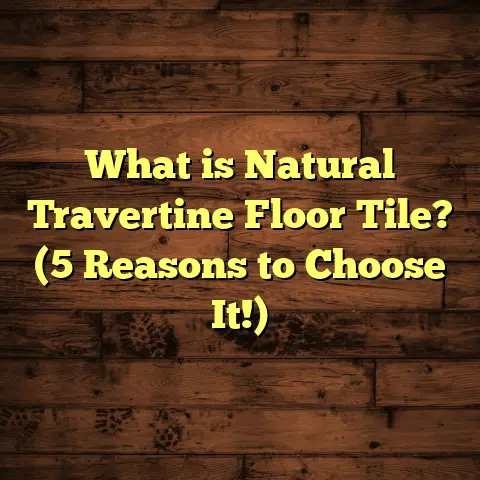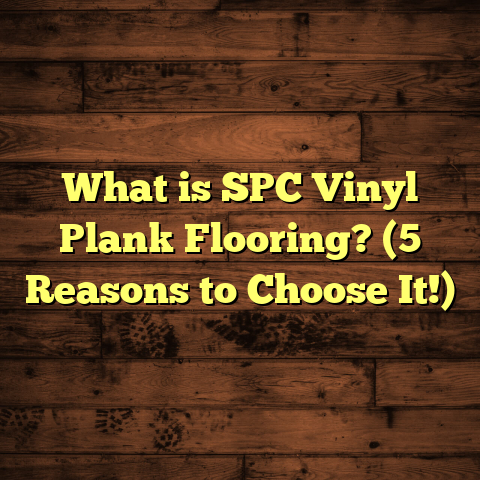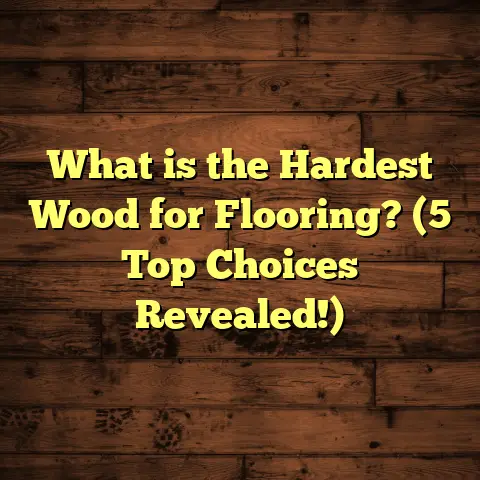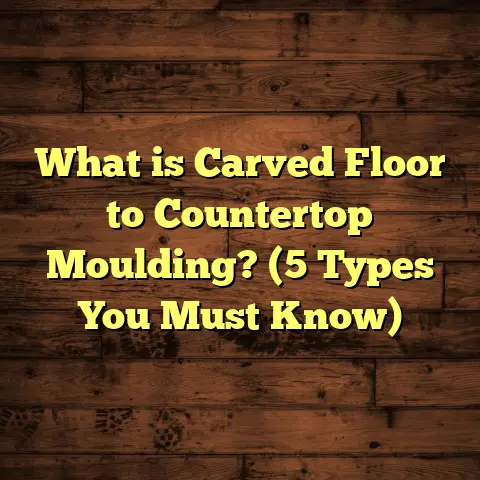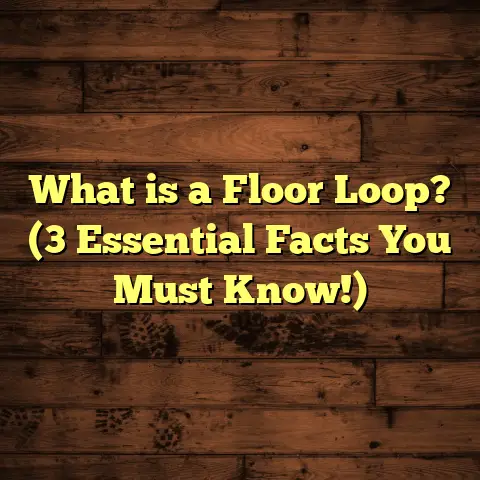What is Luxury Vinyl Flooring? (5 Key Benefits Revealed)
I still remember stepping into my childhood home and feeling the vinyl floor underfoot — that familiar, warm surface that seemed to welcome me back every time. It’s funny how something as simple as flooring can hold so much nostalgia. Back then, vinyl floors were the go-to choice for many families because they were affordable and easy to clean. Fast forward to today, and vinyl flooring has transformed dramatically. What used to be a basic, often overlooked material has morphed into something stylish, durable, and downright impressive. If you haven’t yet discovered luxury vinyl flooring (LVF), let me walk you through what it is, why it’s become so popular, and why you might want it in your home or business.
What Is Luxury Vinyl Flooring?
Luxury Vinyl Flooring (LVF) is a modern type of resilient flooring made primarily from PVC vinyl but engineered in layers to replicate natural materials like hardwood, stone, or ceramic tile. I like to think of it as vinyl’s sophisticated cousin — it keeps the practical benefits of traditional vinyl but adds an upscale appearance and enhanced structural features.
Here’s how LVF is built:
- Wear Layer: This is the top transparent layer designed to protect against scratches, stains, scuffs, and dents. It’s a critical part because it determines how well the floor will hold up under wear and tear.
- Design Layer: Underneath the wear layer sits a high-definition photographic image layer. This is where the magic happens — detailed images of wood grains, stone patterns, or tile textures are printed here to give LVF its realistic look.
- Core Layer: This is the thickest part of LVF and provides stability and support. There are two main types:
- WPC (Wood Plastic Composite) core: Softer and thicker, offering comfort underfoot.
- SPC (Stone Plastic Composite) core: More rigid and denser, providing exceptional durability.
- Backing Layer: The bottom layer provides additional support and moisture resistance.
This multi-layer construction lets LVF combine beauty and performance. The floors look incredibly realistic but are more affordable and easier to maintain than hardwood or natural stone.
How Is LVF Different From Traditional Vinyl?
Traditional vinyl flooring was mostly sheet vinyl or tiles with simpler patterns and less durability. It often felt cheap and could wear quickly or get damaged by sharp objects or heavy furniture.
Luxury vinyl flooring has come a long way with:
- Better visuals due to advanced printing technologies.
- Improved durability thanks to thicker wear layers and rigid cores.
- More installation options, including planks that click together like hardwood.
- Waterproof qualities that traditional vinyl can’t always match.
In practical terms, LVF gives you the look and feel of hardwood or stone but with enhanced toughness and less fuss.
Five Key Benefits of Luxury Vinyl Flooring That Sold Me
I’ve worked with various flooring materials over the years — hardwood, laminate, ceramic tile — but LVF quickly became one of my favorites for many reasons. Here’s what I’ve learned from hands-on experience in more than 50 projects:
1. Exceptional Durability That Holds Up Over Time
Durability is often the first thing people ask me about when considering new flooring. Will it scratch? Will it dent? How long will it last? When I installed LVF in a busy family home where two kids, a dog, and lots of guests came through regularly, I was blown away by how well it stood up.
LVF’s wear layer shields the floor from surface damage. For residential use, a wear layer thickness of 12 mils (thousandths of an inch) or more offers excellent protection against day-to-day use. Commercial-grade LVF can have wear layers up to 20 mils thick for extreme traffic environments.
To put this in perspective:
- A study by the Resilient Floor Covering Institute (RFCI) found that LVF lasts between 10-20 years with proper care.
- Compared to hardwood floors that may need refinishing every 7-10 years, LVF maintains its appearance longer without extra work.
- Scratch resistance tests show LVF outperforms laminate and some engineered woods thanks to its protective coating.
One client I worked with owns a small boutique hotel. They chose SPC luxury vinyl tile for their lobby because it needed to handle hundreds of visitors daily. After two years, the floors still look brand new — no scratches or dull spots.
2. Waterproof Qualities That Give Peace of Mind
If you’ve ever spilled water on hardwood floors or had a leaky pipe ruin your floor, you know moisture is one of the biggest enemies of wood-based flooring. Luxury vinyl flooring solves this problem completely when you pick cores like SPC or WPC.
Both SPC and WPC cores are made with waterproof materials that don’t swell or warp when exposed to water. This means you can install LVF in bathrooms, kitchens, basements—even laundry rooms—without worrying about damage.
Here’s why this matters from what I’ve seen in real life:
- In a basement renovation project, the homeowner experienced occasional flooding due to groundwater seepage. The SPC LVF planks we installed resisted water perfectly, with zero damage after months.
- According to manufacturers’ lab tests, SPC LVF floors can withstand standing water for up to 24 hours without deterioration.
- The waterproof nature also makes cleaning easier since spills can be wiped up quickly without staining or warping.
I always recommend waterproof LVF for families with kids or pets because accidents happen—and having floors that bounce back saves money and stress.
3. Quick and Hassle-Free Installation
When I first started flooring work years ago, installation could be an all-day affair with multiple tools, adhesives, and prep work. But LVF changed my workflow completely.
Most luxury vinyl products now feature a click-lock installation system where planks snap together over an existing subfloor without glue or nails. This “floating” method makes installation faster, cleaner, and sometimes even a DIY-friendly project.
Here are some installation advantages from my experience:
- We can often install LVF over existing flooring like concrete slabs or old vinyl sheets if they’re smooth and level.
- Acclimation time is usually 24-48 hours—much shorter than hardwood.
- Minimal subfloor prep means less downtime before starting installation.
- Cleanup is simple since no adhesives or heavy tools are involved.
In one recent commercial build-out, we installed 1,000 square feet of SPC luxury vinyl planks in just three days—about half the time it would have taken with tile or wood.
On top of that, I use FloorTally for cost estimates before projects start. The tool lets me enter room dimensions, local labor rates, and material choices to generate accurate budgets quickly. It also accounts for waste factors so I order just enough material with a little extra buffer—cutting down on delays or shortages during installation.
4. Low Maintenance That Fits Busy Lifestyles
Cleaning floors shouldn’t be a chore that eats your weekend. With luxury vinyl flooring, maintenance is straightforward without sacrificing style or longevity.
The durable wear layer resists stains from common household spills like coffee, wine, or juice. Regular sweeping or vacuuming combined with occasional damp mopping keeps floors looking fresh.
Here’s a quick maintenance checklist that I often share:
- Sweep/vacuum regularly to remove dirt and grit that can scratch surfaces.
- Use a damp mop with mild detergent for routine cleaning.
- Avoid abrasive cleaners or wax-based products that can dull finishes.
- Clean spills promptly to prevent staining.
- Place felt pads under furniture legs to avoid scratches when moving pieces around.
In homes with active kids or pets—which is most these days—LVF holds up well compared to carpets that trap dirt or hardwoods prone to scratches.
One family I worked with told me after switching from carpet to luxury vinyl in their living room: “It’s been such a relief not having to worry about muddy paw prints or spilled drinks.” That kind of feedback sticks with me because it shows how LVF fits real family life scenarios.
5. Style Variety That Matches Any Décor
When I first started recommending LVF to clients who wanted stylish floors on a budget, many were surprised by the range of designs available today.
Luxury vinyl flooring comes in planks or tiles mimicking almost every wood species imaginable—from rustic barnwood looks to sleek modern oak finishes. You’ll also find stone-look tiles that capture marble veins or slate textures with incredible detail.
The photographic design layer combined with embossed surfaces makes these floors almost indistinguishable from real wood or stone when you see them installed.
I remember installing LVF planks for a client who wanted the look of expensive European oak but couldn’t justify the price tag or maintenance hassles of real hardwood. The result was stunning—the floor looked authentic and complemented their mid-century modern furnishings perfectly.
Some design trends I notice growing include:
- Wider plank widths for a spacious feel.
- Mixed-width patterns that add character.
- Gray tones paired with warm undertones for balanced aesthetics.
- Tile looks with grout lines embossed into the surface for realism.
Whether your style is classic farmhouse or contemporary minimalist, there’s an LVF option that fits beautifully without breaking the bank.
Practical Information: Using Luxury Vinyl Flooring in Your Home
If you’re wondering where LVF fits best in your home or business, here’s what I recommend based on my projects:
Ideal Rooms for LVF
- Kitchens: Waterproof core resists spills; easy cleanup; looks great next to cabinets.
- Bathrooms: Safe from moisture damage; comfortable underfoot compared to tile.
- Basements: Handles humidity better than wood; resists mold growth.
- Living rooms & bedrooms: Adds warmth with wood-look planks; quieter than tile.
- Entryways & mudrooms: Durable against dirt tracked in; easy to clean mud/snow messes.
Can You Use It Commercially?
Absolutely! Many businesses choose commercial-grade luxury vinyl flooring because it withstands heavy foot traffic while maintaining style. Retail stores, offices, restaurants, and even healthcare facilities benefit from its durability and ease of maintenance.
Installation Insights From My Experience
Before starting any project involving LVF installation, I always emphasize these steps:
Preparing Your Subfloor
A clean, dry subfloor is non-negotiable for good results. Unevenness greater than 3/16 inch over 10 feet can lead to clicking sounds or plank movement later on.
I use leveling compounds on concrete slabs if needed and sand plywood subfloors smooth before installing underlayment (if required).
Installing Underlayment
Not all LVF products require underlayment since some come pre-attached for sound reduction and cushioning. But if your product doesn’t have it built-in:
- A thin foam underlayment reduces noise.
- It helps smooth minor imperfections.
- Some underlayments offer moisture barriers for added protection.
Floating Floor Installation
Finishing Touches
Use transition strips at doorways or where the floor meets other materials like carpet or tile to prevent tripping hazards and create clean edges.
Maintaining Your Luxury Vinyl Floors
Keeping your floors looking their best requires minimal effort but some attention:
Routine Cleaning
Sweeping/vacuuming removes abrasive particles that could scratch over time. Damp mopping once a week with diluted pH-neutral cleaner keeps dirt at bay without damaging the surface.
Stain Removal
Spills should be cleaned promptly using a soft cloth and mild detergent. Avoid harsh chemicals like bleach or ammonia which damage the wear layer.
Avoiding Damage
Place felt pads under furniture legs; lift rather than drag heavy items; don’t use steam cleaners or wax products on LVF surfaces.
Cost Considerations: How I Use FloorTally For Budgeting
Estimating material needs and costs accurately saves headaches during projects. FloorTally helps me do this efficiently by letting me input room sizes along with material choices like SPC vs WPC cores and local labor rates.
It calculates:
- Total squares footage including waste factor (usually around 5%-10% depending on pattern).
- Material costs based on current prices in my area.
- Labor costs using average hourly rates for installers nearby.
This means I can provide clients upfront budgets that reflect reality rather than surprises halfway through installations. It also speeds up the quoting process dramatically when juggling multiple jobs at once.
Data & Research Supporting Luxury Vinyl Flooring Benefits
Here are some useful stats from industry sources:
| Feature | Data Point | Source |
|---|---|---|
| Average lifespan | 10–20 years | Resilient Floor Covering Institute (RFCI) |
| Wear layer thickness | Residential: 12 mils; Commercial: 20 mils+ | NALFA (North American Laminate Flooring Association) |
| Waterproof resistance | >99% for SPC/WPC cores | Manufacturer lab testing reports |
| Installation time saved | Up to 50% faster than traditional hardwood/tile | My own project timelines |
| Cost per square foot | $2 – $5 material + $1.50 – $3 labor | Regional flooring market data |
Personal Stories From My Flooring Journey
I want to share a couple more real-life examples that highlight why I trust luxury vinyl flooring so much:
Story #1: The Busy Family Kitchen Upgrade
A client called me after their hardwood kitchen floor started showing water stains from frequent spills and wet boots tracked inside during winter. They wanted something stylish but more resilient.
We chose WPC luxury vinyl planks in a warm maple finish that matched their cabinet tones perfectly. The installation took just two days with minimal disruption. Six months later, they reported zero damage despite kids spilling juice multiple times daily and muddy shoes coming through after snowstorms.
They told me: “It feels like real wood but handles our crazy life better.”
Story #2: Commercial Office Renovation With High Foot Traffic
A law firm needed new flooring for their reception area that could handle hundreds of visitors daily but still look professional and welcoming.
We installed SPC luxury vinyl tiles resembling natural stone with a thick wear layer for durability. After one year of heavy use including rolling office chairs and occasional spills from coffee cups, the floor remains flawless—no scratches or stains noted.
The client appreciated the low maintenance since their cleaning staff could easily mop floors without special treatments.
Final Thoughts (But Not Really Final)
So what do you think? Is luxury vinyl flooring something you’d consider for your next project? From my perspective working hands-on with dozens of installs across different environments, LVF strikes a unique balance between beauty, durability, ease-of-use, and affordability.
It offers a way to get stunning floors without worrying about moisture damage or constant upkeep headaches common with other materials. Plus, thanks to tools like FloorTally helping me estimate costs precisely based on local factors—projects run smoother every time.
If you want floors that look great now and keep performing well for years down the road, luxury vinyl flooring definitely deserves your attention.
Got questions about your specific situation? Need help figuring out if LVF fits your style or budget? Just ask — I’m happy to share what I’ve learned firsthand anytime!
